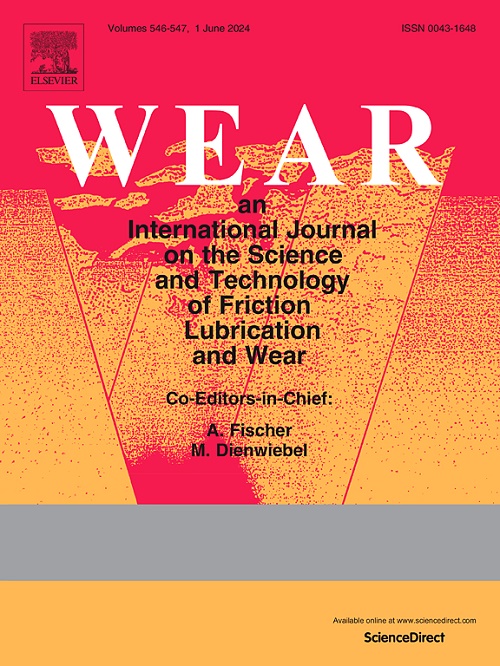新型 Al0.5CrFeNiV0.5 高熵合金的微观结构、力学性能和高温滑动磨损响应
IF 5.3
1区 工程技术
Q1 ENGINEERING, MECHANICAL
引用次数: 0
摘要
本研究开发了一种新的含钒高熵合金(HEA),其化学成分为 Al0.5CrFeNiV0.5。通过 X 射线衍射、扫描电子显微镜和透射电子显微镜等多种技术对其微观结构特征和相组成进行了研究。铸造后的 Al0.5CrFeNiV0.5 HEA 平均维氏硬度约为 570.5 HV,抗压强度约为 2.53 GPa,塑性约为 22.1%。此外,HEA 在 600 °C 时仍表现出极高的抗压强度(约 1218.6 MPa),但在 700 °C 时迅速降至约 586 MPa,在 800 °C 时降至 301 MPa。另一方面,对铸态 HEA 与 Si3N4 陶瓷球的高温滑动磨损测试表明,在 RT 和 800 °C 之间,摩擦系数在 0.4-0.5 范围内略有变化。然而,HEA 的磨损率随着温度的升高而单调增加,尤其是当温度超过 600 °C 时磨损率更高。根据化学成分分析、磨损表面形态观察以及磨损轨迹截面特征,详细讨论了相关机理。本文章由计算机程序翻译,如有差异,请以英文原文为准。
Microstructure, mechanical properties and high-temperature sliding wear response of a new Al0.5CrFeNiV0.5 high-entropy alloy
In this study, a new V-containing high-entropy alloy (HEA) with the chemical composition of Al0.5CrFeNiV0.5 has been developed. Its microstructural features and phase constitutions were investigated by several techniques, including X-ray diffraction, scanning electron microscopy, and transmission electron microscopy. The as-cast Al0.5CrFeNiV0.5 HEA exhibits an average Vickers hardness of around 570.5 HV, a compressive strength of about 2.53 GPa and a plasticity of around 22.1 %. In addition, the HEA still exhibits very high compressive strength of about 1218.6 MPa at 600 °C, but it decreases quickly to around 586 MPa at 700 °C and 301 MPa at 800 °C. On the other hand, high-temperature sliding wear tests of as-cast HEA against the Si3N4 ceramic balls revealed a slight change of friction coefficient in a range of 0.4–0.5 between RT and 800 °C. However, the wear rate of HEA was found to increase monotonically with increasing the temperature, and was particularly higher when temperature exceeded 600 °C. The associated mechanisms have been discussed in details based on chemical composition analysis, worn surface morphology observations as well as the characterizations of the wear track cross-sections.
求助全文
通过发布文献求助,成功后即可免费获取论文全文。
去求助
来源期刊

Wear
工程技术-材料科学:综合
CiteScore
8.80
自引率
8.00%
发文量
280
审稿时长
47 days
期刊介绍:
Wear journal is dedicated to the advancement of basic and applied knowledge concerning the nature of wear of materials. Broadly, topics of interest range from development of fundamental understanding of the mechanisms of wear to innovative solutions to practical engineering problems. Authors of experimental studies are expected to comment on the repeatability of the data, and whenever possible, conduct multiple measurements under similar testing conditions. Further, Wear embraces the highest standards of professional ethics, and the detection of matching content, either in written or graphical form, from other publications by the current authors or by others, may result in rejection.
 求助内容:
求助内容: 应助结果提醒方式:
应助结果提醒方式:


